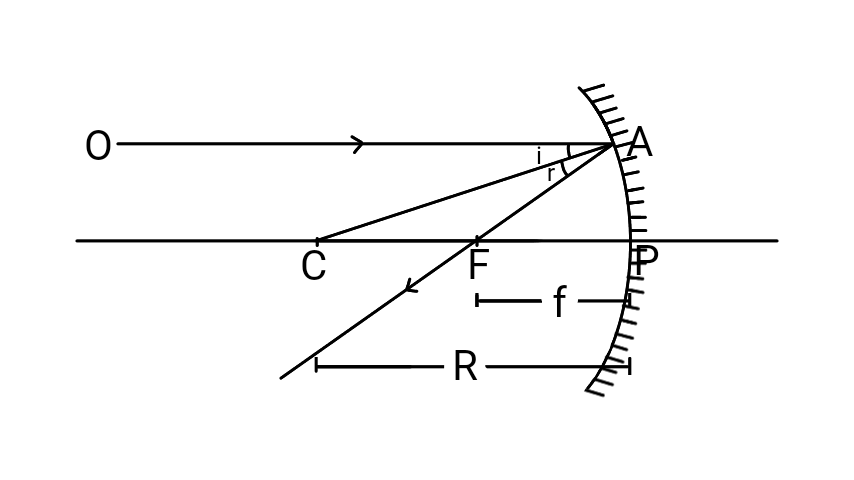
Derive $ R = 2f $ for a spherical mirror, where the symbols have their usual meaning.
Answer
498k+ views
Hint :First law of reflection states that the incident ray, reflected ray and normal, all lie in the same plane. Second law of reflection states that the angle of reflection is always equal to the angle of incidence. The angles are measured relative to the perpendicular to the surface at the point where the ray strikes the surface.
Complete Step By Step Answer:
Let $ OA $ be the incident ray and $ CA $ be the line normal to the surface at the point $ A $ where the ray $ \left( {OA} \right) $ strikes the surface of a spherical mirror. Let $ f $ and $ R $ be the focal length and radius of curvature. Also let $ i $ and $ r $ be the angle of incidence and the angle of reflection. Then we can draw the figure as follows

Hence $ FP = f $ and $ CP = R $ .
Also $ C $ is the centre of the circle and $ R $ is also the radius of the sphere.
According to second law of reflection
$ i = r $ ----(1)
Since $ OA $ is parallel to $ CP $ we get $ \left| \!{\underline {\,
{ACP} \,}} \right. = \left| \!{\underline {\,
{OAC} \,}} \right. = i $ ---(2)
From the equation (1), the equation (2) becomes
$ \left| \!{\underline {\,
{ACP} \,}} \right. = i = r = \left| \!{\underline {\,
{CAF} \,}} \right. $
Then $ \Delta ACF $ is an isosceles triangle. Therefore $ CF = FA $ ---(3)
For mirror of small aperture we get $ FA \approx FP $ ---(4)
From the equation (3) and (4), we get
$ CF = FP $ ---(5)
then $ CP = CF + FP = FP + FP = 2\;FP $
$ \Rightarrow R = 2f $ .
Hence the proof.
Note :
Myopia(near-sightedness) is corrected by using a Concave Lens of suitable power. Hypermetropia(farsightedness) is corrected by using a convex lens of suitable power. A spherical mirror is a mirror which has the shape of a piece cut out of a spherical surface. There are two types of spherical mirrors: concave, and convex.
Complete Step By Step Answer:
Let $ OA $ be the incident ray and $ CA $ be the line normal to the surface at the point $ A $ where the ray $ \left( {OA} \right) $ strikes the surface of a spherical mirror. Let $ f $ and $ R $ be the focal length and radius of curvature. Also let $ i $ and $ r $ be the angle of incidence and the angle of reflection. Then we can draw the figure as follows

Hence $ FP = f $ and $ CP = R $ .
Also $ C $ is the centre of the circle and $ R $ is also the radius of the sphere.
According to second law of reflection
$ i = r $ ----(1)
Since $ OA $ is parallel to $ CP $ we get $ \left| \!{\underline {\,
{ACP} \,}} \right. = \left| \!{\underline {\,
{OAC} \,}} \right. = i $ ---(2)
From the equation (1), the equation (2) becomes
$ \left| \!{\underline {\,
{ACP} \,}} \right. = i = r = \left| \!{\underline {\,
{CAF} \,}} \right. $
Then $ \Delta ACF $ is an isosceles triangle. Therefore $ CF = FA $ ---(3)
For mirror of small aperture we get $ FA \approx FP $ ---(4)
From the equation (3) and (4), we get
$ CF = FP $ ---(5)
then $ CP = CF + FP = FP + FP = 2\;FP $
$ \Rightarrow R = 2f $ .
Hence the proof.
Note :
Myopia(near-sightedness) is corrected by using a Concave Lens of suitable power. Hypermetropia(farsightedness) is corrected by using a convex lens of suitable power. A spherical mirror is a mirror which has the shape of a piece cut out of a spherical surface. There are two types of spherical mirrors: concave, and convex.
Recently Updated Pages
Why are manures considered better than fertilizers class 11 biology CBSE

Find the coordinates of the midpoint of the line segment class 11 maths CBSE

Distinguish between static friction limiting friction class 11 physics CBSE

The Chairman of the constituent Assembly was A Jawaharlal class 11 social science CBSE

The first National Commission on Labour NCL submitted class 11 social science CBSE

Number of all subshell of n + l 7 is A 4 B 5 C 6 D class 11 chemistry CBSE

Trending doubts
What is meant by exothermic and endothermic reactions class 11 chemistry CBSE

10 examples of friction in our daily life

One Metric ton is equal to kg A 10000 B 1000 C 100 class 11 physics CBSE

1 Quintal is equal to a 110 kg b 10 kg c 100kg d 1000 class 11 physics CBSE

Difference Between Prokaryotic Cells and Eukaryotic Cells

What are Quantum numbers Explain the quantum number class 11 chemistry CBSE




